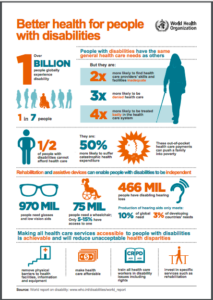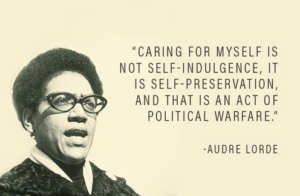7 Ways to Make Your Activism More Inclusive of Activists with Disabilities

Posted by Nicole Gathany
September 12, 2019
In April, I broke my ankle which severely limited my normal activity and opened my eyes to how ableist the world is. That includes activist spaces. Yes—even yours.

It was a temporary disability, but I also was diagnosed with a long term (invisible) disability two years ago. I’ve also had a chronic disease since childhood that sometimes makes activists and social spaces inaccessible to me.
I am a chapter leader for URGE ATL, the Atlanta City Activist Network for URGE and participate in reproductive justice work with other organizations in Atlanta. This means I have experienced what people have done right by disabled people and what they can improve on. So, here is a list of ways folks can make their activist spaces more inclusive of disabled activists.
1. Recognize that disabilities are quite common.
The Woke Olympics can be ableist af, y’all. I remember last year, I was attending training on speaking to legislators and during the discussion, a white ally felt the need to say “Stop tweeting and get up off your ass!” I immediately quipped “What if they can’t get up off their ass?” This person looked at me with disgust and rolled their eyes saying, “Well. Of course!”
This dismissive attitude implied to me, that disabilities were the exception to the rule and not the norm. But the reality is disabilities are quite common. And according to the CDC, 1 in 5 adults has a disability and they are more common in some communities and regions than others.
2. Make room for different forms of activism and keep in mind that community organizing is a group effort.
The comment and response described in #1 were ableist. But aside from that, they erased the fact that not all activism or organizing involves marching in the streets. Community organizing includes a myriad of processes including making phone calls to supporters, creating signs, planning, developing strategy, feeding other organizers by ordering food, writing letters to your legislator or trans women in prison, raising bailout funds for people in jail for not paying traffic tickets, setting up healing circles for other organizers and more. None of those require “getting up off your ass.”
Staying home and tweeting ARE important. Digital organizing, for example, is an entire field, there is even a digital organizing fellowship program called The Kairos Fellowship for activists interested in this work.
3. Be mindful of invisible disabilities.
You cannot tell if someone is disabled just by looking at them because not all disabilities are visible. Earlier this year, reproductive justice, rights, and health groups in Georgia were spending every day at the capitol to pressure legislators to vote no on HB481, a bill that eventually and effectively banned abortion in Georgia. As the URGE ATL chapter president, I asked several of our community members to join us at the capitol to protest. Although some folks were available, they could not come due to disabilities I did not know that they had.
I will not out our members but I will say that disabilities, in general, can include mobility (serious difficulty walking or climbing stairs), cognitive (serious difficulty concentrating, remembering or making decisions), vision (serious difficulty seeing), self-care (difficulty dressing or bathing) and independent living (difficulty doing errands alone). Many of these can be seen or unseen. Sometimes, the inability to imagine these invisible disabilities leads to an unfair policing of disabled people.
4. Ask each attendee about their accessibility needs before events and actions.
Related to number three, you cannot always tell someone is disabled just by looking at them, so it’s important to ask everyone about their accessibility needs. That way you can plan according and make sure all folks feel they can participate.
Here is a checklist to help organizers plan more accessible events.
5. Be mindful that for many, disabilities cannot be separated from their other marginalized identities
According to the Behavioral Risk Factor Surveillance System in 2013, women, older people, and people of color were more likely to report having a disability.
For me as someone living with Post Traumatic Stress Disorder, which I developed as a result of the sexual violence I experienced, I often wonder if I would have experienced this trauma, in the same way, were I not a black queer woman. Especially considering 9 out of 10 survivors are women according to RAINN and that’s just based on the information that’s reported.
My PTSD, which involves depression and anxiety, sometimes makes it difficult to participate in some actions. Some events and actions can trigger my PTSD and make sick to my stomach.
Additionally, according to the World Health Organization, disabled people are likely to experience economic stress due to medical expenses which often leads to poverty. Therefore, lack of funds or lack of access to transportation can also make activism less accessible to disabled people. If your organization has the ability, provide carpooling or ride shares to actions and events.

6. Make sure your event or action is accessible every step of the way.
Asking attendees about their accessibility needs is just the first step. The worst thing you can do is fall through at the end of an event.
This summer I went to a certain march (won’t say which one), but I was experiencing pain in my ankles and could not march the whole way so I took the bus they provided for physically disabled people. It turned out they provided a bus for the march but they did not provide a bus afterward. Luckily, I was able to use a rideshare service paid for by URGE but for others, this may have created an undue burden.
Don’t just ask about accessibility to check off boxes. Demonstrate that you actually care about disabled folks.
7. Center community care.
If you Google my name, you might find a picture of me with a quote by my name saying that I see self-care as a form of resistance. I love Audre Lorde and I love her quote on self-care which says, “Caring for myself is not self-indulgence. It is self-preservation and that is an act of political warfare.”
However, self-care is not accessible to everyone in the same way and the modern self-care movement can be incredibly ableist, especially in the US which tends to be very culturally individualistic.

This is where community care comes in. A few years ago, I attended a march against police brutality in Atlanta, but I had to leave because several people there were smoking tobacco and my asthma makes it so that I stop breathing if I breathe in too much tobacco smoke. I later contacted the organizers of the march and told them about my asthma and they told me there was nothing they could do about that.
I was turned off from direct actions for years following that even. Eventually, a friend of mine who organizes communities in Queens, NY against police brutality reassured me that what those organizers did was wrong because paraphrasing Assata Shakur, in community organizing it’s our job to protect and take care of each other.
Many of the steps above can help with community care. In the situation I described above, centering community care could have looked like asking people to smoke in a designated area to care for those with respiratory issues.
This isn’t an exhaustive list and I have left out plenty of other things you can do for folks with disabilities. However, this is a great start that shows your commitment to disabled folks. Comment if you have any additional ideas on how to make activism more inclusive of disabled activists!
Leave a Reply
You must be logged in to post a comment.

